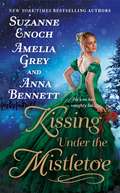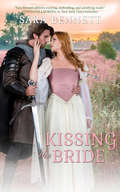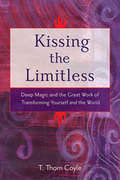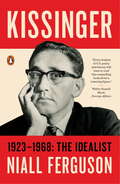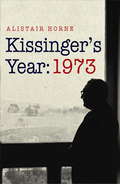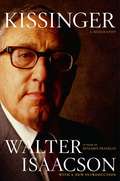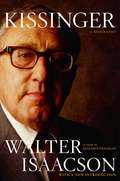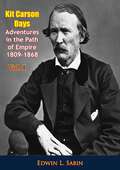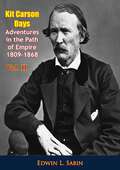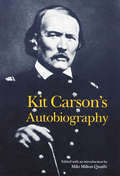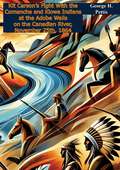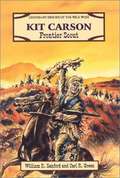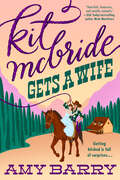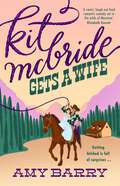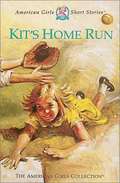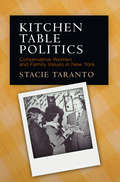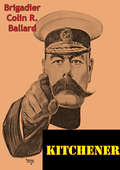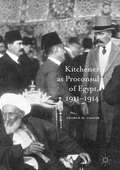- Table View
- List View
Kissing Under the Mistletoe
by Suzanne Enoch Amelia Grey Anna BennettFrom the Scottish highlands, to the bustle and tussle of London, to a hotel on the outskirts of town, three unforgettable authors bring the joy of Christmas romance in Kissing Under the Mistletoe.Great Scot! by Suzanne EnochMiss Jane Bansil knows she will never have a fairy-tale moment. Well past the marriageable age, she’s taken a position as a companion and is now stuck in Scotland for Christmas, alone even in the middle of the boisterous MacTaggert family. But when Brennan Andrews, an architect and cousin to the MacTaggerts, arrives to draw up plans for a new family home, Jane must decide if she will take a chance at a happily-ever-after, or settle into her small, safe life for good.Christmas at Dewberry Hollow by Amelia Grey Miss Isabelle Reed has no plans to ever fall in love. She has a perfectly acceptable life with her mother at the Dewberry Hollow Inn, thank you very much. But when Gate, the Duke of Notsgrave’s grandson, appears at Dewberry Hollow searching for a carving on a tree, Isabelle cannot help but get involved. But Gate’s charm and their instant attraction makes Isabelle question if she’s willing to take her chance at love once again.My Mistletoe Beau by Anna BennettMiss Eva Tiding is determined to cheer her widowed father with the perfect Christmas gift. Even if it means breaking into the home of the rakish Earl of Frostbough who swindled Papa out of his pocket watch. But when the earl, Jack Hardwick, catches her in the act, they strike a deal: she’ll pose as his fiancée in exchange for the watch. Falling in love is not part of the plan—but with a little Christmas magic, anything is possible…
Kissing the Bride
by Sara BennettAn Unexpected PassionYoung widow, Lady Jenova of Gunlinghorn knows she must marry again, but is unsure of the bridegroom that has been chosen. However, she knows she can trust her devilishly handsome childhood friend, Lord Henry, who now advises the King! When they are trapped together by a winter tempest, she and Henry shock themselves by surrendering to a wildly passionate indiscretion. And suddenly Jenova must rethink her wedding plans…“Sara Bennett is one of today’s most gifted romance writers. She writes with passion and truly gets into the ‘heads’ of her characters making them come to life for all of us to enjoy.”—Joyfully Reviewed“Bennett gets this true-to-life tale of medieval life exactly right.”—>i?Romantic Times
Kissing the Limitless: Deep Magic and the Great Work of Transforming Yourself and the World
by T. Thorn CoyleThis book was written to be used in concert with whatever pagan tradition you are currently involved in. There are at least three levels to it: part one will help you strengthen the foundations of your spiritual practice, part two will ensure that you are sound in body, mind, emotion, sex, and spirit, and have developed will and ethics, and part three will lead you further into connection with your Godhood. . . The tools used to do this are breath work, dream work, pendulum work, aura reading, tarot, meditation, spells, and others. The goal of the book is to help guide you through the stages of personal consciousness that will then enable you to step into inclusive consciousness—a consciousness that encompasses the personal, political, environmental, social, mental, and transpersonal. [It is this] inclusive consciousness [that] enables us to reach the limitless, the divine, Goddess or God.
Kissinger
by Niall FergusonThe definitive biography of Henry Kissinger, based on unprecedented access to his private papersNo American statesman has been as revered or as reviled as Henry Kissinger. Once hailed as "Super K"--the "indispensable man" whose advice has been sought by every president from Kennedy to Obama--he has also been hounded by conspiracy theorists, scouring his every "telcon" for evidence of Machiavellian malfeasance. Yet as Niall Ferguson shows in this magisterial two-volume biography, drawing not only on Kissinger's hitherto closed private papers but also on documents from more than a hundred archives around the world, the idea of Kissinger as the ruthless arch-realist is based on a profound misunderstanding.The first half of Kissinger's life is usually skimmed over as a quintessential tale of American ascent: the Jewish refugee from Hitler's Germany who made it to the White House. But in this first of two volumes, Ferguson shows that what Kissinger achieved before his appointment as Richard Nixon's national security adviser was astonishing in its own right. Toiling as a teenager in a New York factory, he studied indefatigably at night. He was drafted into the U.S. infantry and saw action at the Battle of the Bulge--as well as the liberation of a concentration camp--but ended his army career interrogating Nazis. It was at Harvard that Kissinger found his vocation. Having immersed himself in the philosophy of Kant and the diplomacy of Metternich, he shot to celebrity by arguing for "limited nuclear war." Nelson Rockefeller hired him. Kennedy called him to Camelot. Yet Kissinger's rise was anything but irresistible. Dogged by press gaffes and disappointed by "Rocky," Kissinger seemed stuck--until a trip to Vietnam changed everything. The Idealist is the story of one of the most important strategic thinkers America has ever produced. It is also a political Bildungsroman, explaining how "Dr. Strangelove" ended up as consigliere to a politician he had always abhorred. Like Ferguson's classic two-volume history of the House of Rothschild, Kissinger sheds dazzling new light on an entire era. The essential account of an extraordinary life, it recasts the Cold War world.
Kissinger and Brzezinski: The NSC and the Struggle for Control of US National Security
by Gerry Argyris AndrianopoulosThe factors which influenced foreign policy under Nixon and Carter.
Kissinger's Year: 1973
by Alistair HorneThe life of Henry Kissinger seen through one seminal year - 1973.1973 was a seminal year in world history. The outbreak of the 'Yom Kippur War' took both Israel and the US by surprise, the Vietnam War finally ended, it was the year of détente with the Soviet Union, but the US executive was in a state of collapse following Watergate, and the year ended with the Muslim-initiated energy crisis, which brought the Western world to the brink of economic disaster - a story of deepest relevance today.This book is the biography of Kissinger - the first he has authorised - viewed through the events of this crucial year. A story of his extraordinarily imaginative aims, his near successes, and, as he admits, his ultimate failures.
Kissinger's Year: 1973
by Sir Alistair Horne CBEThe life of Henry Kissinger seen through one seminal year - 1973.1973 was a seminal year in world history. The outbreak of the 'Yom Kippur War' took both Israel and the US by surprise, the Vietnam War finally ended, it was the year of détente with the Soviet Union, but the US executive was in a state of collapse following Watergate, and the year ended with the Muslim-initiated energy crisis, which brought the Western world to the brink of economic disaster - a story of deepest relevance today.This book is the biography of Kissinger - the first he has authorised - viewed through the events of this crucial year. A story of his extraordinarily imaginative aims, his near successes, and, as he admits, his ultimate failures.
Kissinger: A Biography
by Walter IsaacsonBy the time Henry Kissinger was made secretary of state in 1973, he had become, according to the Gallup Poll, the most admired person in America and one of the most unlikely celebrities ever to capture the world's imagination. Yet Kissinger was also reviled by large segments of the American public, ranging from liberal intellectuals to conservative activists. Kissinger explores the relationship between this complex man's personality and the foreign policy he pursued. Drawing on extensive interviews with Kissinger as well as 150 other sources, including U. S. presidents and his business clients, this first full-length biography makes use of many of Kissinger's private papers and classified memos to tell his uniquely American story. The result is an intimate narrative, filled with surprising revelations, that takes this grandly colorful statesman from his childhood as a persecuted Jew in Nazi Germany, through his tortured relationship with Richard Nixon, to his later years as a globe-trotting business consultant.
Kissinger: A Biography
by Walter IsaacsonThe definitive biography of Secretary of State Henry Kissinger and how his ideas still resonate in the world today from the bestselling author of Leonardo da Vinci and Steve Jobs.By the time Henry Kissinger was made secretary of state in 1973, he had become, according to the Gallup Poll, the most admired person in America and one of the most unlikely celebrities ever to capture the world's imagination. Yet Kissinger was also reviled by large segments of the American public, ranging from liberal intellectuals to conservative activists. Kissinger explores the relationship between this complex man&’s personality and the foreign policy he pursued. Drawing on extensive interviews with Kissinger as well as 150 other sources, including US presidents and his business clients, this first full-length biography makes use of many of Kissinger&’s private papers and classified memos to tell his uniquely American story. The result is an intimate narrative, filled with surprising revelations, that takes this grandly colorful statesman from his childhood as a persecuted Jew in Nazi Germany, through his tortured relationship with Richard Nixon, to his later years as a globe-trotting business consultant.
Kit
by Marina FioratoAn unforgettable historical romance based on an astonishing true story from international bestseller Mariano Fiorato - perfect for fans of Poldark and The Scandalous Lady W.Dublin 1702. Irish beauty Kit Kavanagh has everything she could want in life. Newly married, she runs a successful alehouse with her beloved husband Richard. The wars that rage in Europe over the Spanish throne seem a world away.But everything changes on the night that Richard simply disappears. Finding the Queen's shilling at the bottom of Richard's tankard, Kit realizes that her husband has been taken for a soldier.Kit follows Richard's trail across the battlefields of Italy in the Duke of Marlborough's regiment. Living as a man, risking her life in battle, she forms a close bond with her wry and handsome commanding officer Captain Ross. When she is forced to flee the regiment following a duel, she evades capture by dressing once more as a woman. But the war is not over for Kit. Her beauty catches the eye of the scheming Duke of Ormonde, who recruits her to spy upon the French. In her finery she meets Captain Ross once again, who seems just as drawn to the woman as he was to the soldier.Torn between Captain Ross and her loyalty to her husband, and under the orders of the English Crown, Kit finds that her life is in more danger now than on the battlefield.(P)2015 Hodder & Stoughton
Kit Carson Days Adventures in the Path of Empire 1809-1868 Vol. I (Kit Carson Days Adventures in the Path of Empire 1809-1868 #1)
by Edwin L. SabinChristopher Houston "Kit" Carson (December 24, 1809 - May 23, 1868) was an American frontiersman. The few paying jobs he had during his lifetime included mountain man (fur trapper), wilderness guide, Indian agent, and American Army officer. Carson became a frontier legend in his own lifetime via biographies and news articles. Exaggerated versions of his exploits were the subject of dime novels. In the 1840s, he was hired as a guide by John C. Fremont. Fremont's expedition covered much of California, Oregon, and the Great Basin area. Fremont mapped and wrote reports and commentaries on the Oregon Trail to assist and encourage westward-bound American pioneers. Carson achieved national fame through Fremont's accounts of his expeditions. Under Fremont's command, Carson participated in the uprising against Mexican rule in California at the beginning of the Mexican-American War. Later in the war, Carson was a scout and courier, celebrated for his rescue mission after the Battle of San Pasqual and for his coast-to-coast journey from California to Washington, DC to deliver news of the conflict in California to the U.S. government. During the American Civil War, Carson led a regiment of mostly Hispanic volunteers from New Mexico on the side of the Union at the Battle of Valverde in 1862.-Print ed.
Kit Carson Days Adventures in the Path of Empire 1809-1868 vol. II (Kit Carson Days Adventures in the Path of Empire 1809-1868 #2)
by Edwin L. SabinChristopher Houston "Kit" Carson (December 24, 1809 - May 23, 1868) was an American frontiersman. The few paying jobs he had during his lifetime included mountain man (fur trapper), wilderness guide, Indian agent, and American Army officer. Carson became a frontier legend in his own lifetime via biographies and news articles. Exaggerated versions of his exploits were the subject of dime novels. In the 1840s, he was hired as a guide by John C. Fremont. Fremont's expedition covered much of California, Oregon, and the Great Basin area. Fremont mapped and wrote reports and commentaries on the Oregon Trail to assist and encourage westward-bound American pioneers. Carson achieved national fame through Fremont's accounts of his expeditions. Under Fremont's command, Carson participated in the uprising against Mexican rule in California at the beginning of the Mexican-American War. Later in the war, Carson was a scout and courier, celebrated for his rescue mission after the Battle of San Pasqual and for his coast-to-coast journey from California to Washington, DC to deliver news of the conflict in California to the U.S. government. During the American Civil War, Carson led a regiment of mostly Hispanic volunteers from New Mexico on the side of the Union at the Battle of Valverde in 1862.-Print ed.
Kit Carson's Autobiography
by Kit Carson Milo Milton Quaife"Notice is hereby given to all persons, that Christopher Carson, a boy about 16 years old, small of his age, but thick-set; light hair, ran away from the subscriber, living in Franklin, Howard County, Missouri, to whom he had been bound to learn the saddler's trade. . . . One cent reward will be given to any person who will bring back the said boy.''This notice appeared in the Missouri Intelligencer of October 6, 1826, at about the same time that Kit Carson, in the humble role of "cavvy boy" in Bent's Santa Fé caravan, embarked upon his notable career. Thirty years later, a postgraduate of the University of the Wilderness, and for a decade past a national hero, he was persuaded to dictate to a literate friend his own story of his life to date.The account—as modest and undemonstrative as Carson's feats were remarkable—covers his life as a trapper, Indian fighter, guide, and buffalo hunter up to the fall of 1856. Among the high spots during these years were his trapping expedition to California with Ewing Young (1829–1831), his celebrated duel with Shunar at the Green River rendezvous of 1837, the three expeditions with John C. Frémont (1842, 1843–1844, 1845), his exploits in the Mexican War (l846–1848), and his service as an Indian agent.
Kit Carson's Fight With the Comanche and Kiowa Indians at the Adobe Walls on the Canadian River, November 25th, 1864
by George H. PettisStep into the dramatic and intense world of the American frontier with George H. Pettis' short, but gripping account, "Kit Carson's Fight With the Comanche and Kiowa Indians at the Adobe Walls on the Canadian River, November 25th, 1864." This detailed narrative chronicles one of the most significant battles in the Indian Wars, offering a vivid portrayal of legendary frontiersman Kit Carson and his confrontation with the Comanche and Kiowa tribes.Pettis provides a compelling account of the events leading up to and during the fierce battle at Adobe Walls. Drawing from firsthand reports and historical records, he paints a vivid picture of the harsh conditions, strategic maneuvers, and brutal combat that defined this pivotal clash. The book delves into the motivations and perspectives of both the Native American tribes defending their homeland and the U.S. military forces led by Carson.This book is an essential read for history enthusiasts, students of the American West, and anyone interested in the legendary figures and events that shaped the nation's frontier history. George H. Pettis' detailed and passionate account ensures that the legacy of Kit Carson and the Battle of Adobe Walls will not be forgotten.
Kit Carson's Long Walk and Other True Tales of Old San Diego
by Henry Schwartz13 tales from the city of San Diego, California in the 1800s.
Kit Carson: Frontier Scout (Legendary Heroes of the Wild West)
by Carl R. Green William R. Sanford- Brings the action of the frontier days to life for the reluctant reader. - Recounts the adventures of the explorers, pioneers, and settlers of the West.
Kit McBride Gets a Wife
by Amy BarryThe four McBride brothers have their worlds turned upside down when their precocious younger sister secretly places an advertisement for a mail-order bride. Kit McBride knows that Buck's Creek, Montana, is no place to find a wife. Between him and his three brothers—plus little Junebug—they manage all right on their own, thank you very much. But unbeknownst to Kit, his sister is sick to death of cleaning, cooking, and mending for her big brothers, so she places an ad in The Matrimonial News to get them hitched. After Maddy Mooney emigrated from Ireland, she found employment with an eccentric but poor widow. When her mistress decides to answer an ad for a mail-order bride, Maddy is dragged along for the ride to Montana. But en route to the West, Maddy is suddenly abandoned and left to assume the widow's name, position, and matrimonial prospects…. With no other recourse in the wilderness, Maddy must convince Kit she&’s the wife he never knew he needed.
Kit McBride Gets a Wife (The McBrides of Montana #1)
by Amy BarryKit McBride is as rugged as they come, but the bookish cowboy is about to embark on the adventure of a lifetime when he&’s saddled with a surprise mail-order bride. A hilarious historical romance for fans of Bridgerton and Calamity Jane. Kit McBride knows that Buck&’s Creek, Montana, is no place to find a wife. Good thing he&’s not looking for one – between him and his brothers, and little sister Junebug, they manage all right on their own, thank you very much. Unbeknownst to Kit, though, Junebug is sick to death of cleaning and cooking for her big brothers, so she places an ad in The Matrimonial News to get him hitched. Maddy Mooney, recently arrived from Ireland, has found employment with an eccentric young widow determined to regain her wealth. And when her mistress decides to answer an ad for a mail-order bride, Maddy is dragged along for the ride. But as soon as they arrive out West, Maddy&’s mistress abandons her to chase fortune further afield, and she is left to assume the widow&’s name, position, and matrimonial prospects. Penniless, and with no other recourse in the wilderness, Maddy must convince Kit she&’s the wife he never knew he needed.
Kit's Home Run (American Girls Short Stories #24)
by Valerie TrippKit Kittridge loves Baseball just about as much as anything else in the world! But with the Great deprssion she has to settle for playing it rather than watching it. One day after playing a game with some of her friends she learns something about one of the borders in her home that she never knew before.
Kit's Story Collection (The American Girls Collection)
by Valerie TrippThis book contains: Meet Kit Kit Learns a Lesson Kit's Surprise Happy Birthday Kit! Kit Saves the Day Changes for Kit All of the books in this volume teach a different type of lesson while telling a fictional story based in a real time period. Also available from Bookshare: "Kit's Home Run."
Kitchen Literacy: How We Lost Knowledge of Where Food Comes from and Why We Need to Get It Back
by Ann VileisisAsk children where food comes from, and they'll probably answer: "the supermarket." Ask most adults, and their replies may not be much different. Where our foods are raised and what happens to them between farm and supermarket shelf have become mysteries. How did we become so disconnected from the sources of our breads, beef, cheeses, cereal, apples, and countless other foods that nourish us every day? Ann Vileisis's answer is a sensory-rich journey through the history of making dinner. Kitchen Literacy takes us from an eighteenth-century garden to today's sleek supermarket aisles, and eventually to farmer's markets that are now enjoying a resurgence. Vileisis chronicles profound changes in how American cooks have considered their foods over two centuries and delivers a powerful statement: what we don't know could hurt us. As the distance between farm and table grew, we went from knowing particular places and specific stories behind our foods' origins to instead relying on advertisers' claims. The woman who raised, plucked, and cooked her own chicken knew its entire life history while today most of us have no idea whether hormones were fed to our poultry. Industrialized eating is undeniably convenient, but it has also created health and environmental problems, including food-borne pathogens, toxic pesticides, and pollution from factory farms. Though the hidden costs of modern meals can be high, Vileisis shows that greater understanding can lead consumers to healthier and more sustainable choices. Revealing how knowledge of our food has been lost and how it might now be regained, Kitchen Literacy promises to make us think differently about what we eat.
Kitchen Table Politics: Conservative Women and Family Values in New York (Politics and Culture in Modern America)
by Stacie TarantoMost histories of modern American politics tell a similar story: that the Sunbelt, with its business friendly environment, right-to-work laws, and fierce spirit of frontier individualism, provided the seedbed for popular conservatism. Stacie Taranto challenges this narrative by positioning New York State as a central battleground. In 1970, under the governorship of Republican Nelson Rockefeller, New York became one of the first states to legalize abortion. By 1980, however, conservative, antifeminist Republicans with broad suburban appeal—symbolized by figures such as Ronald Reagan—had usurped power from these so-called Rockefeller Republicans. What happened during the intervening decade?In Kitchen Table Politics, Taranto investigates the role that middle-class, mostly Catholic women played both in the development of conservatism in New York State and in the national shift toward a conservative politics of "family values." Far from Albany, a short train ride away from the feminist activity in New York City, white, Catholic homemakers on Long Island and in surrounding suburban counties saw the legalization of abortion in the state in 1970 as a threat to their hard-won version of the American dream. Borrowing tactics from church groups and parent-teacher associations, these women created the New York State Right to Life Party and organized against several feminist initiatives, including defeating an effort to add an Equal Rights Amendment to the state constitution in 1975.These self-described "average housewives," Taranto argues, were more than just conservative shock troops; instead, they were inventing a new, politically viable conservatism centered on the heterosexual traditional nuclear family that the GOP's right wing used to broaden its electoral base. Figures such as activist Phyllis Schlafly, New York senator Al D'Amato, and presidential hopeful Ronald Reagan viewed the Right to Life Party's activism as offering a viable model to defeat feminist initiatives and win family values votes nationwide. Taranto gathers archival evidence and oral histories to piece together the story of these homemakers, whose grassroots organizing would shape the course of modern American conservatism.
Kitchen Things: An Album of Vintage Utensils and Farm-Kitchen Recipes
by Richard SnodgrassMany home cooks--and professionals, as well--swear by the tried-and-true implements they've used for years: the Foley Food Mill that works like a charm every time; the manually operated juicer that's a tradition of family breakfasts; the cast iron skillet that's been handed down through the generations. For serious cooks, there's nothing like a familiar implement, a thing that works exactly as you expect it to.Similarly, most people usually have a library of favorite recipes on which they rely: some passed along from relatives and friends, others from mentors and teachers. These are the recipes cooks return to time and time again, in part because they evoke memories of the people who have enjoyed them and prepared them in the past.Kitchen Things, by master photographer and respected novelist Richard Snodgrass, celebrates these well-loved objects and recipes and showcases them in an unexpected way--a way that touches upon the science of food, the physics of cooking, the sensory pleasures of eating, and indeed the very nature of life itself.In his reflections, the author is aided by his patient, persistent, and very perceptive wife, Marty, and her mother, from whose Western Pennsylvania farmhouse kitchens the objects and recipes were sourced. The gentle, often humorous repartee between the author and these wise and knowing women forms a running narrative throughout the book.
Kitchener [Illustrated Edition]
by Brigadier Colin R. BallardIncludes 17 maps and the First World War Illustrations Pack - 73 battle plans and diagrams and 198 photosField-Marshal Horatio Herbert Kitchener served in the British Army from his teenage years in the Royal Engineers to his elevation to the highest military rank forty-four years later in 1916. In this balanced biography, written by a fellow British Army officer who served in the First World War, his long career in the army and as a colonial administrator is charted in vivid detail.Kitchener came to worldwide attention in 1898 for winning the Battle of Omdurman and securing control of the Sudan, after which he was given the title "Lord Kitchener of Khartoum"; as Chief of Staff (1900-02) in the Second Boer War he played a key role in Lord Roberts' conquest of the Boer Republics, then succeeded Roberts as commander-in-chief-ultimately winning the war against the insurgent Boers. After a quarrelsome term as Commander-in-Chief (1902-09) in India he returned to Egypt as Consul-General.In 1914, at the start of the First World War, Lord Kitchener became Secretary of State for War, a Cabinet Minister. One of the few to foresee a long war, he organised the largest volunteer army that both Britain and the world had seen, and oversaw a significant expansion of materials production to fight Germany on the Western Front. Despite having warned of the difficulty of provisioning Britain for a long war, he was blamed for the shortage of shells in the spring of 1915 - one of the events leading to the formation of a coalition government - and stripped of his control over munitions and strategy.Kitchener drowned on 5 June 1916 when HMS Hampshire sank west of the Orkney Islands, Scotland. He was making his way to Russia in order to attend negotiations but the ship struck a German mine. He was one of the 600 killed on board the ship.
Kitchener as Proconsul of Egypt, 1911-1914
by George. H. CassarThis book covers the tenure of Kitchener as Proconsul in Egypt in the years preceding the First World War. Based mostly on unpublished sources - including government records and private papers - it not only fills a gap in the life and career of Kitchener, the most famous soldier in Britain since Wellington, but it also deals with an important but practically unknown period in Egyptian history. George Cassar shows Kitchener to be an ardent imperialist, but one who had a sense of responsibility to the country he governed. Exchanging his field marshal's uniform for the dress of a statesman, he arrived in Egypt when British prestige was at a low point on account of his predecessor's policies. He restored political stability, created conditions that bolstered the economy, and introduced a wave of reforms. Kitchener as Proconsul of Egypt, 1911-1914 reveals how Kitchener's interest extended beyond Egypt, and how throughout these years he worked quietly to prepare the ground in an attempt to create an Arab Empire under Britain's suzerainty.
